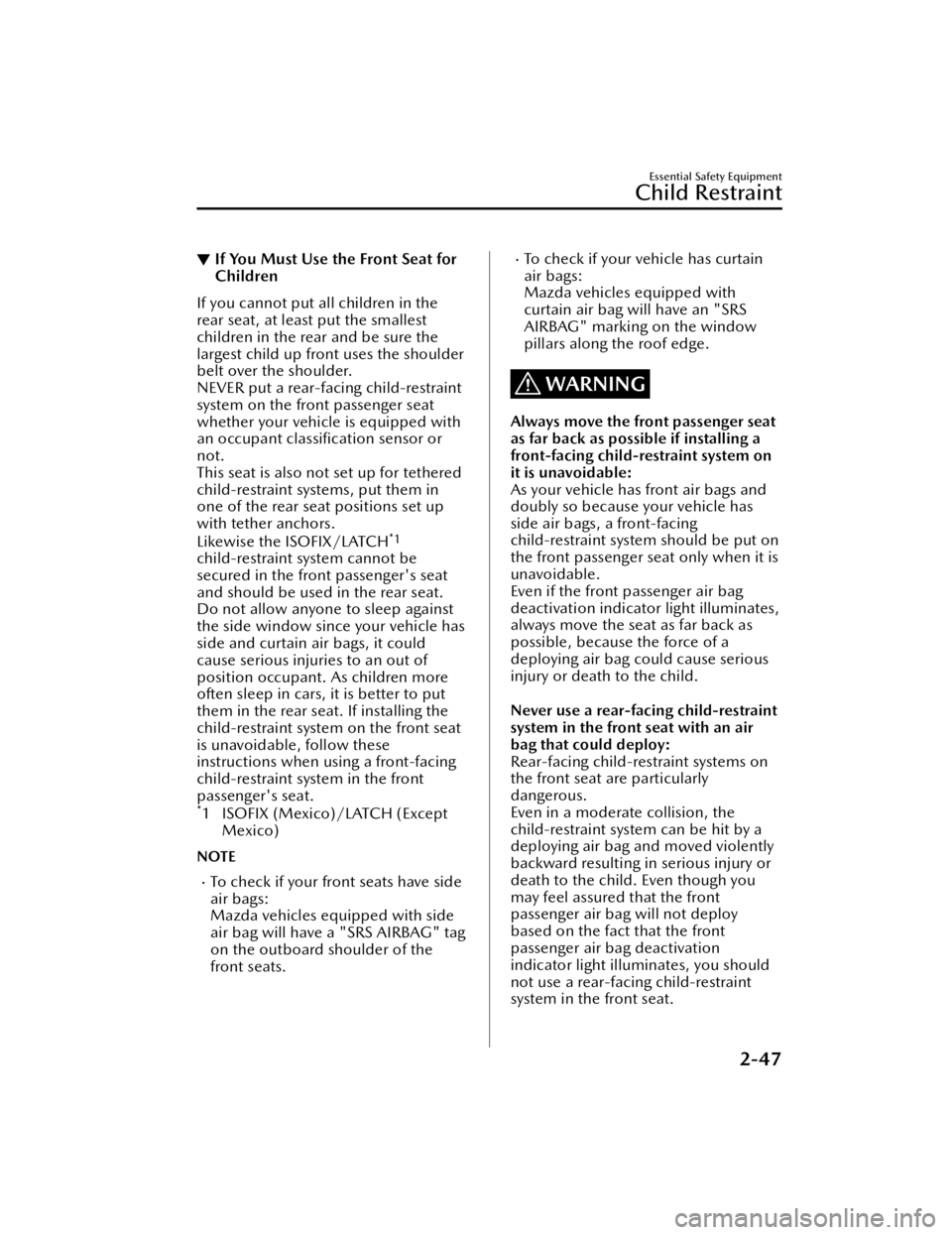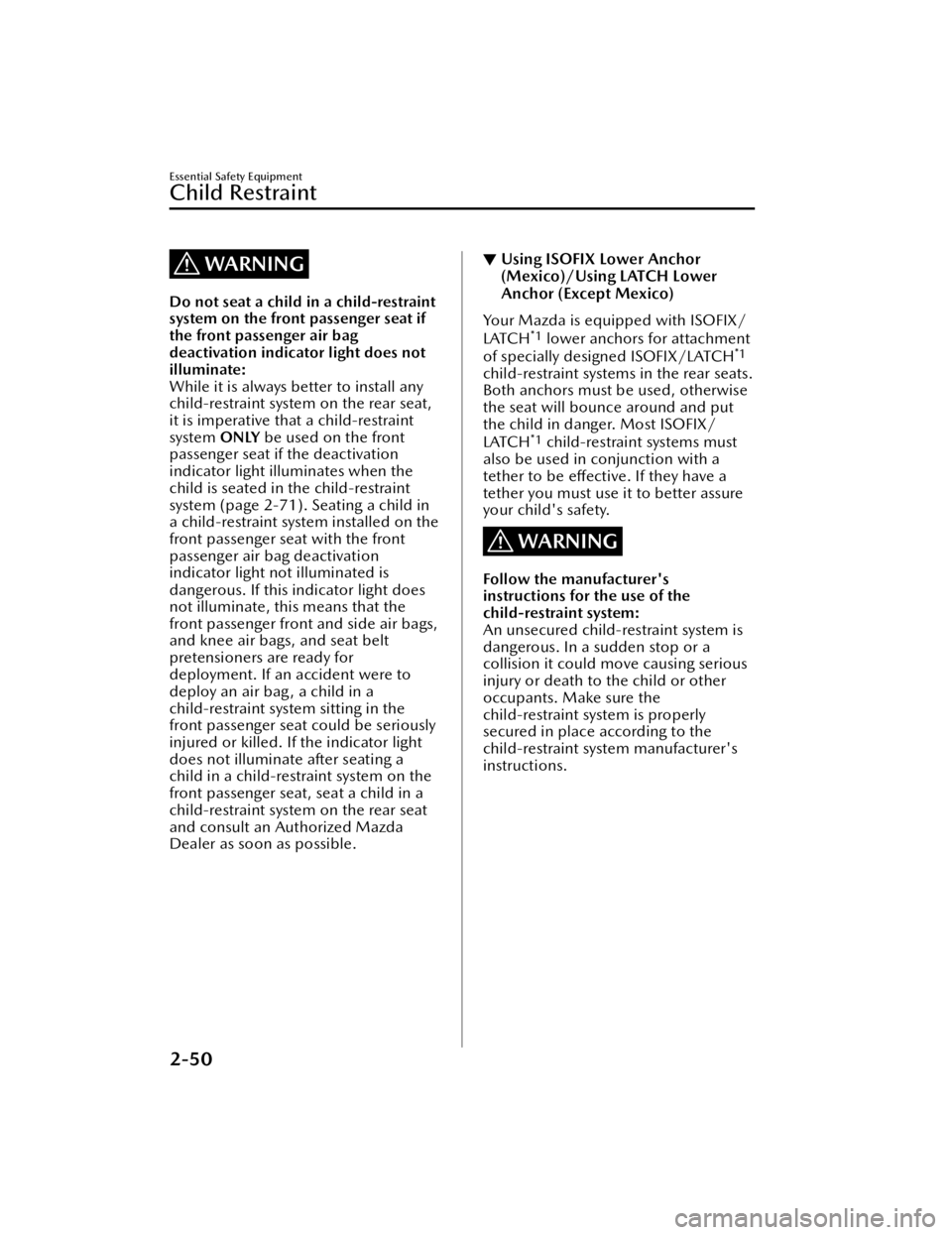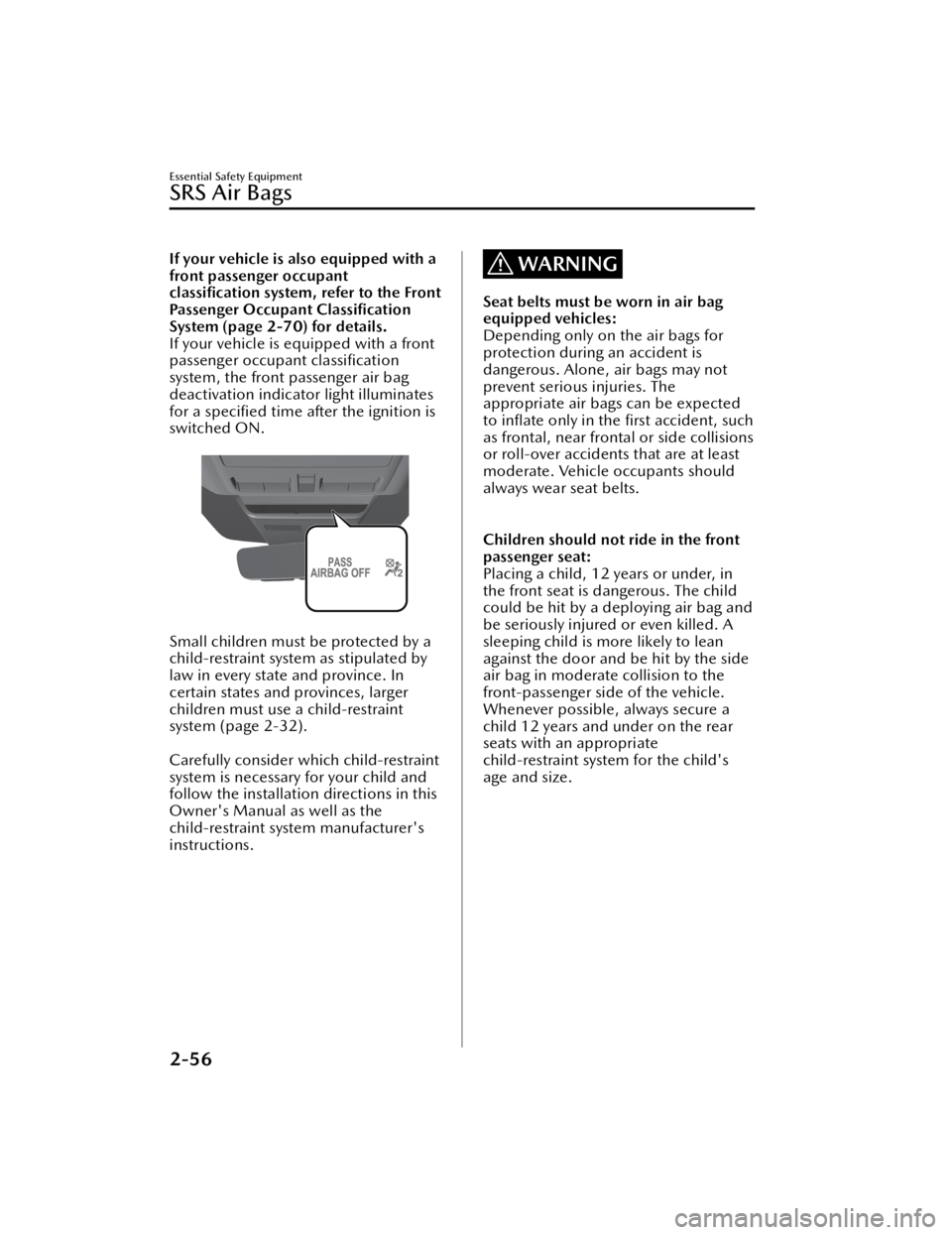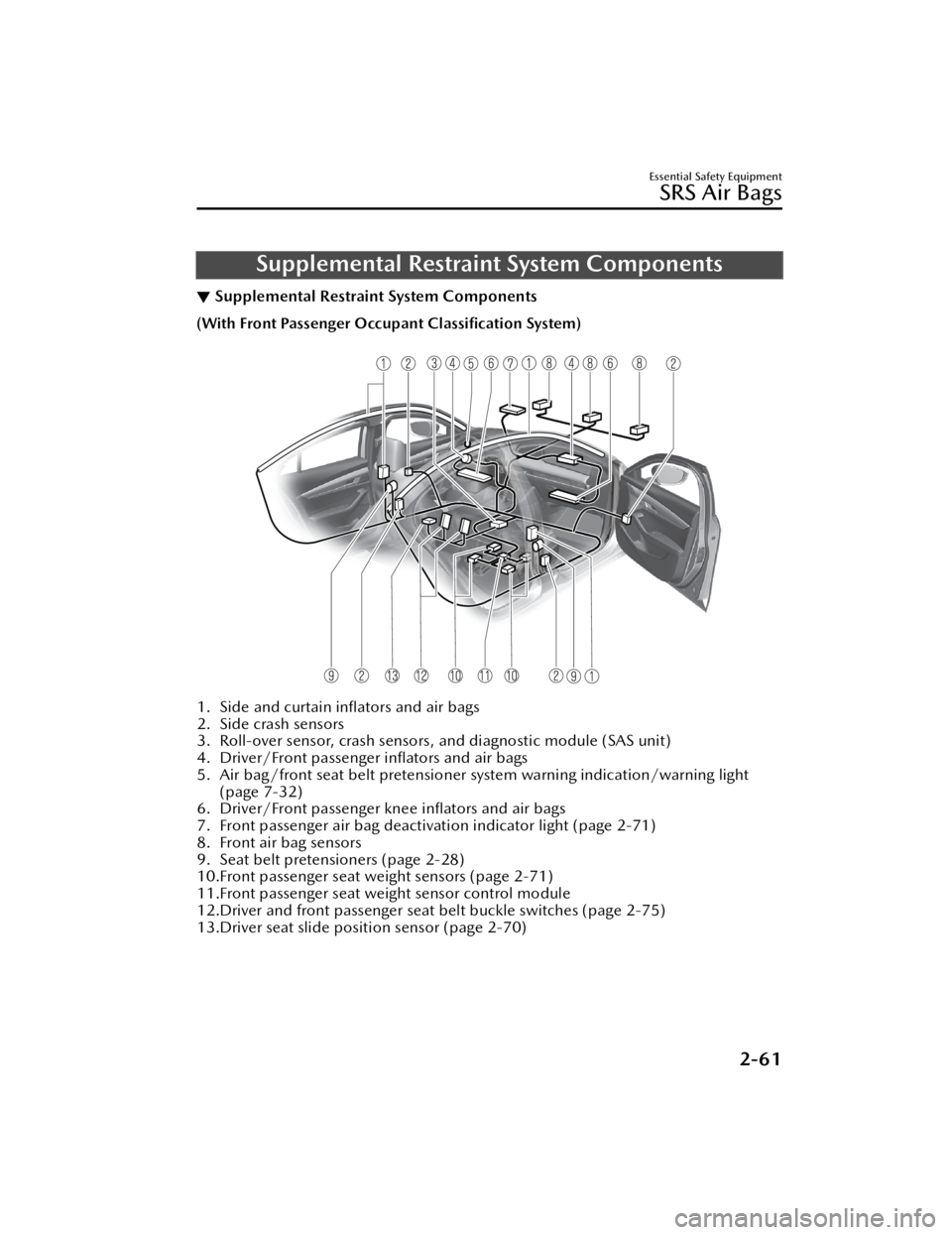warning MAZDA MODEL 3 HATCHBACK 2021 Owner's Manual
[x] Cancel search | Manufacturer: MAZDA, Model Year: 2021, Model line: MODEL 3 HATCHBACK, Model: MAZDA MODEL 3 HATCHBACK 2021Pages: 612, PDF Size: 89.06 MB
Page 61 of 612

▼If You Must Use the Front Seat for
Children
If you cannot put all children in the
rear seat, at least put the smallest
children in the rear and be sure the
largest child up front uses the shoulder
belt over the shoulder.
NEVER put a rear-facing child-restraint
system on the front passenger seat
whether your vehicle is equipped with
an occupant classi
fication sensor or
not.
This seat is also not set up for tethered
child-restraint systems, put them in
one of the rear seat positions set up
with tether anchors.
Likewise the ISOFIX/LATCH
*1
child-restraint system cannot be
secured in the front passenger's seat
and should be used in the rear seat.
Do not allow anyone to sleep against
the side window since your vehicle has
side and curtain air bags, it could
cause serious injuries to an out of
position occupant. As children more
often sleep in cars, it is better to put
them in the rear seat. If installing the
child-restraint system on the front seat
is unavoidable, follow these
instructions when using a front-facing
child-restraint system in the front
passenger's seat.
*1 ISOFIX (Mexico)/LATCH (Except Mexico)
NOTE
To check if your front seats have side
air bags:
Mazda vehicles equipped with side
air bag will have a "SRS AIRBAG" tag
on the outboard shoulder of the
front seats.
To check if your vehicle has curtain
air bags:
Mazda vehicles equipped with
curtain air bag will have an "SRS
AIRBAG" marking on the window
pillars along the roof edge.
WARNING
Always move the front passenger seat
as far back as possible if installing a
front-facing child-restraint system on
it is unavoidable:
As your vehicle has front air bags and
doubly so because your vehicle has
side air bags, a front-facing
child-restraint system should be put on
the front passenger seat only when it is
unavoidable.
Even if the front passenger air bag
deactivation indicator light illuminates,
always move the seat as far back as
possible, because the force of a
deploying air bag could cause serious
injury or death to the child.
Never use a rear-facing child-restraint
system in the front seat with an air
bag that could deploy:
Rear-facing child-restraint systems on
the front seat are particularly
dangerous.
Even in a moderate collision, the
child-restraint system can be hit by a
deploying air bag and moved violently
backward resulting in serious injury or
death to the child. Even though you
may feel assured that the front
passenger air bag will not deploy
based on the fact that the front
passenger air bag deactivation
indicator light illuminates, you should
not use a rear-facing child-restraint
system in the front seat.
Essential Safety Equipment
Child Restraint
2-47
Mazda3_8JM2-EA -20H_Edition1_new 2020-7-10 17:21:34
Page 64 of 612

WARNING
Do not seat a child in a child-restraint
system on the front passenger seat if
the front passenger air bag
deactivation indicator light does not
illuminate:
While it is always better to install any
child-restraint system on the rear seat,
it is imperative that a child-restraint
system ONLY be used on the front
passenger seat if the deactivation
indicator light illuminates when the
child is seated in the child-restraint
system (page 2-71). Seating a child in
a child-restraint system installed on the
front passenger seat with the front
passenger air bag deactivation
indicator light not illuminated is
dangerous. If this indicator light does
not illuminate, this means that the
front passenger front and side air bags,
and knee air bags, and seat belt
pretensioners are ready for
deployment. If an accident were to
deploy an air bag, a child in a
child-restraint system sitting in the
front passenger seat could be seriously
injured or killed. If the indicator light
does not illuminate after seating a
child in a child-restraint system on the
front passenger seat, seat a child in a
child-restraint system on the rear seat
and consult an Authorized Mazda
Dealer as soon as possible.
▼ Using ISOFIX Lower Anchor
(Mexico)/Using LATCH Lower
Anchor (Except Mexico)
Your Mazda is equipped with ISOFIX/
LATCH*1 lower anchors for attachment
of specially designed ISOFIX/LATCH*1
child-restraint systems in the rear seats.
Both anchors must be used, otherwise
the seat will bounce around and put
the child in danger. Most ISOFIX/
LATCH
*1 child-restraint systems must
also be used in conjunction with a
tether to be e ffective. If they have a
tether you must use it to better assure
your child's safety.
WARNING
Follow the manufacturer's
instructions for the use of the
child-restraint system:
An unsecured child-restraint system is
dangerous. In a sudden stop or a
collision it could move causing serious
injury or death to the child or other
occupants. Make sure the
child-restraint system is properly
secured in place according to the
child-restraint system manufacturer's
instructions.
Essential Safety Equipment
Child Restraint
2-50
Mazda3_8JM2-EA -20H_Edition1_new 2020-7-10 17:21:34
Page 66 of 612

3. Remove the cover of thechild-restraint system's ISOFIX/
LATCH
*1 lower anchors to verify the
locations of the ISOFIX/LATCH*1
lower anchors.
1. Lower anchor
NOTE
The ISOFIX/LATCH*1 lower
anchors marking on the cover
indicates the position of the
ISOFIX/LATCH
*1 lower anchors
for the attachment of a
child-restraint system.
Store the removed cover so that it
does not get lost.
4. Remove the head restraint.
However, when installing a backless
booster seat, always install the
vehicle head restraint to the seat
where the backless booster seat is
installed.
Refer to Head Restraints on page
2-17.
5. Secure the child-restraint system
using BOTH ISOFIX/LATCH
*1 lower
anchors, following the
child-restraint system
manufacturer's instruction. Pull on
the child-restraint to be sure both
anchors are engaged.
6. If your child-restraint system came equipped with a tether, that means
it is very important to properly
secure the tether for child safety.
Please carefully follow the
child-restraint system
manufacturer's instructions when
installing tethers.
*1 ISOFIX (Mexico)/LATCH (ExceptMexico)
WARNING
Use the tether and tether anchor only
for a child-restraint system:
Using the tether or tether anchor to
secure anything but a child-restraint
system is dangerous. This could
weaken or damage the tether or tether
anchor and result in injury.
Always remove the head restraint and
install child-restraint system (except
when installing a backless booster
seat):
Installing a child-restraint system
without removing the head restraint is
dangerous. The child-restraint system
cannot be installed correctly which
may result in death or injury to the
child in a collision.
(4–Door)
1. Tether strap
Essential Safety Equipment
Child Restraint
2-52
Mazda3_8JM2-EA -20H_Edition1_new 2020-7-10 17:21:34
Page 68 of 612

ISOFIX/LATCH*1 lower anchor
location
WARNING
Always remove the head restraint and
install child-restraint system (except
when installing a backless booster
seat):
Installing a child-restraint system
without removing the head restraint is
dangerous. The child-restraint system
cannot be installed correctly which
may result in death or injury to the
child in a collision.
(4–Door)
1. Tether strap
2. Anchor bracket
(5–Door)
1. Tether strap
2. Anchor bracket
3. Forward
Always attach the tether strap to the
correct tether anchor position:
Attaching the tether strap to the
incorrect tether anchor position is
dangerous. In a collision, the tether
strap could come off and loosen the
child-restraint system. If the
child-restraint system moves it could
result in death or injury to the child.
Always install the head restraint and
adjust it to the appropriate position
after removing the child-restraint
system:
Driving with the head restraint
removed is dangerous as impact to the
occupant's head cannot be prevented
during emergency braking or in a
collision, which could result in a
serious accident, injury or death.
Refer to Head Restraints on page 2-17.
*1 ISOFIX (Mexico)/LATCH (Except Mexico)
Essential Safety Equipment
Child Restraint
2-54
Mazda3_8JM2-EA -20H_Edition1_new 2020-7-10 17:21:34
Page 70 of 612

If your vehicle is also equipped with a
front passenger occupant
classification system, refer to the Front
Passenger Occupant Classi fication
System (page 2-70) for details.
If your vehicle is equipped with a front
passenger occupant classi fication
system, the front passenger air bag
deactivation indicator light illuminates
for a speci fied time after the ignition is
switched ON.
Small children must be protected by a
child-restraint system as stipulated by
law in every state and province. In
certain states and provinces, larger
children must use a child-restraint
system (page 2-32).
Carefully consider which child-restraint
system is necessary for your child and
follow the installation directions in this
Owner's Manual as well as the
child-restraint system manufacturer's
instructions.
WARNING
Seat belts must be worn in air bag
equipped vehicles:
Depending only on the air bags for
protection during an accident is
dangerous. Alone, air bags may not
prevent serious injuries. The
appropriate air bags can be expected
to in flate only in the first accident, such
as frontal, near frontal or side collisions
or roll-over accidents that are at least
moderate. Vehicle occupants should
always wear seat belts.
Children should not ride in the front
passenger seat:
Placing a child, 12 years or under, in
the front seat is dangerous. The child
could be hit by a deploying air bag and
be seriously injured or even killed. A
sleeping child is more likely to lean
against the door and be hit by the side
air bag in moderate collision to the
front-passenger side of the vehicle.
Whenever possible, always secure a
child 12 years and under on the rear
seats with an appropriate
child-restraint system for the child's
age and size.
Essential Safety Equipment
SRS Air Bags
2-56
Mazda3_8JM2-EA -20H_Edition1_new 2020-7-10 17:21:34
Page 75 of 612

Supplemental Restraint System Components
▼Supplemental Restraint System Components
(With Front Passenger Occupant Classifi
cation System)
1. Side and curtain inflators and air bags
2. Side crash sensors
3. Roll-over sensor, crash sensors, and diagnostic module (SAS unit)
4. Driver/Front passenger in flators and air bags
5. Air bag/front seat belt pretensioner system warning indication/warning light (page 7-32)
6. Driver/Front passenger knee in flators and air bags
7. Front passenger air bag deactivation indicator light (page 2-71)
8. Front air bag sensors
9. Seat belt pretensioners (page 2-28)
10.Front passenger seat we ight sensors (page 2-71)
11.Front passenger seat weight sensor control module
12.Driver and front passenger seat belt buckle switches (page 2-75)
13.Driver seat slide position sensor (page 2-70)
Essential Safety Equipment
SRS Air Bags
2-61
Mazda3_8JM2-EA -20H_Edition1_new 2020-7-10 17:21:34
Page 76 of 612

(Without Front Passenger Occupant Classification System)
1. Side and curtain inflators and air bags
2. Side crash sensors
3. Driver/Front passenger in flators and air bags
4. Air bag/ front seat belt pretensioner system warning indication
/warning light (page 7-32)
5. Driver knee in flator and air bag
6. Front air bag sensor
7. Seat belt pretensioners (page 2-28)
8. Crash sensors, and diagnostic module (SAS unit)
Essential Safety Equipment
SRS Air Bags
2-62
Mazda3_8JM2-EA -20H_Edition1_new 2020-7-10 17:21:34
Page 80 of 612

(With Front Passenger Occupant
Classification System)
In a roll-over:
In response to a vehicle roll-over, both
curtain air bags infl ate.
Both curtain air bags will deploy after
the roll-over accident is detected.
▼ Warning Light/Beep
A system malfunction or operation
conditions are indicated by a warning.
Refer to Air Bag/Front Seat Belt
Pretensioner System Warning
Indication/Warning Light on page
7-32.
Essential Safety Equipment
SRS Air Bags
2-66
Mazda3_8JM2-EA
-20H_Edition1_new 2020-7-10 17:21:34
Page 84 of 612

Limitations to roll-over detection
(With Front Passenger Occupant
Classification System):
The following illustration is an example
of an accident that may not be
detected as a roll-over accident.
Therefore, the front seat belt
pretensioners and curtain air bags may
not deploy.
Pitch end over end
Driver and Front
Pa s s e n g e r O cc u p a n t
Classi fication System
*
▼ Driver and Front Passenger
Occupant Classi
fication System
First, please read "Supplemental
Restraint System (SRS) Precautions"
(page 2-55) carefully.
▼ Driver Seat Slide Position Sensor
Your vehicle is equipped with a driver
seat slide position sensor as a part of
the supplemental restraint system. The
sensor is located under the driver seat.
The sensor determines whether the
driver seat is fore or aft of a reference
position and sends the seat position to
the diagnostic module (SAS unit).
The SAS unit is designed to control the
deployment of the driver air bag
depending on how close the driver
seat is to the steering wheel.
The air bag/front seat belt
pretensioner system warning light
fl
ashes if the sensor has a possible
malfunction (page 2-66).
Essential Safety Equipment
SRS Air Bags
2-70*Some models.
Mazda3_8JM2-EA -20H_Edition1_new 2020-7-10 17:21:34
Page 85 of 612

▼Front Passenger Seat Weight
Sensors
Your vehicle is equipped with a front
passenger seat weight sensors as a part
of the supplemental restraint system.
These sensors are located under both
of the front passenger seat rails. These
sensors determine the total seated
weight on the front passenger seat and
monitor the seat belt buckle for the
front passenger seat. The SAS unit is
designed to prevent the front
passenger front and side air bags and
knee air bags, and seat belt
pretensioner system from deploying if
the front passenger air bag
deactivation indicator light illuminates.
To reduce the chance of injuries
caused by deployment of the front
passenger air bag, the system
deactivates the front passenger front
and side air bags and knee air bags,
and also the seat belt pretensioner
system when the front passenger air
bag deactivation indicator light
illuminates. Refer to the following
table for the front passenger air bag
deactivation indicator light
illumination conditions.
This system shuts o
ff the front
passenger front and side air bags and
knee air bags, and seat belt
pretensioner system, so make sure the
front passenger air bag deactivation
indicator light illuminates according to
the following table.
The air bag/front seat belt
pretensioner system warning light
fl ashes and the front passenger air bag
deactivation indicator light illuminates
if the sensors have a possible
malfunction. If this happens, the front
passenger front and side air bags and
knee air bags, and seat belt
pretensioner system will not deploy.
Front passenger air bag deactivation
indicator light
This indicator light illuminates to
remind you that the front passenger
front and side air bags and knee air
bags, and seat belt pretensioners will
not deploy during a collision.
Essential Safety Equipment
SRS Air Bags
2-71
Mazda3_8JM2-EA -20H_Edition1_new 2020-7-10 17:21:34